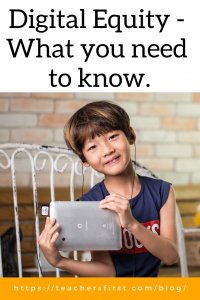 Digital equity……what does it mean? According to the National Digital Inclusion Alliance (NDIA) “Digital Equity is a condition in which all individuals and communities have the information technology capacity needed for full participation in our society, democracy, and economy. Digital Equity is necessary for civic and cultural participation, employment, lifelong learning, and access to essential services.” In plain English from ISTE (International Society for Technology in Education), digital equity is equal access and opportunity to digital tools, resources, and services to increase digital knowledge, awareness, and skills. What does this mean for all of us as educators? For educators, this means doing what you can to make sure students have equal access to devices, software, the internet, and assisting them in learning the proper use of these items.
Digital equity……what does it mean? According to the National Digital Inclusion Alliance (NDIA) “Digital Equity is a condition in which all individuals and communities have the information technology capacity needed for full participation in our society, democracy, and economy. Digital Equity is necessary for civic and cultural participation, employment, lifelong learning, and access to essential services.” In plain English from ISTE (International Society for Technology in Education), digital equity is equal access and opportunity to digital tools, resources, and services to increase digital knowledge, awareness, and skills. What does this mean for all of us as educators? For educators, this means doing what you can to make sure students have equal access to devices, software, the internet, and assisting them in learning the proper use of these items.
Digital equity is not just all about the access. In the short term, Digital equity has been shown to make it easier for students to complete homework, give them access to technology outside of school time, improve parent-teacher communication, and provide students with digital citizenship education. In the long term, we must remember that we are preparing our students for a future in which technology skills will play a large role, and digital equity will ensure that the entire future workforce is prepared to meet the future demand for technology skills.
There are many resources available for educators, schools, and districts looking to assist in bringing about digital equity in their communities. ESchool News recently published an article with ten examples and resources to address digital equity which include advice about going 1:1, home access gaps, and connecting students with digital resources during school breaks. COSN (Consortium for School Networking) produces a digital equity initiative toolkit that highlights district strategies to implement that will help students with internet access as well as community partnership suggestions. Join a group working for digital equity, like ISTE’s Digital Equity Network. Become a Digital Equity Champion by working with Everyoneon. Encourage your district to join the Future Ready Schools Digital Equity Program. Share resources with your students like community spaces that offer free internet access, devices, programs, and help like their public libraries. Teach them digital literacy skills.
Digital equity is an issue that we as educators should all be concerned about. We can work together to assure that all students everywhere will have the necessary tools and skills be technologically ready for the future!


Distance Learning 2020
Yes! Distance learning 2020 has certainly brought the equity issues into the spotlight. Internet access at home, access to technology, services/support for all student populations, teacher support, SEL/mental health support, parent support, ( https://www.edsurge.com/news/2020-03-26-equity-isn-t-just-about-technology-it-s-about-supporting-students-and-families) and more are all issues that districts are realizing that they need to take into account and quickly. Educators can ask questions (https://edtrust.org/resource/10-questions-for-equity-advocates-to-ask-about-distance-learning/), advocate for their students (https://edtrust.org/covid-19-impact-on-education-equity-resources-responding/), and do all that they can to make sure that their classes are as equitable as possible (https://www.commonsense.org/education/articles/7-ways-to-make-distance-learning-more-equitable) during this time and moving forward. Everyone needs to work together to make sure no students are left behind.
If anything, the need for remote learning has made this now a MUST-DO priority!
So true even for our young learners.
Our school makes digital resources available to all students for online learning. Sometimes the problem is with the parents who do not understand the technology so have a difficult time supporting their kids.
I agree. It is exciting that we recognize this and we want to do something about it.
The best way we could achieve this is if the Federal Government just made free high speed internet available to everyone, as has already occurred in other countries.
For many, we take the availability and ease of accessing technology for granted. Not until the pandemic of 2020 did I realize how logistically complicated it is to make this available to all.
Kalamazoo has done a remarkable job at getting hotspots and equipment to all of our school families…the next challenge will be addressing the learning curve and disparities that exist between our families